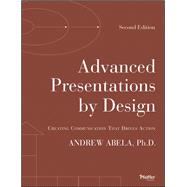Based on extensive research studies from the fields of communication, marketing, psychology, multimedia, and law, Advanced Presentations by Design, Second Edition, provides fact-based answers to the most-often-asked questions about presentation design. The book shows how to adapt your presentation to different audience personality preferences, what role your data should play and how much of it you need, how to turn your data into a story, and how to design persuasive yet comprehensible visual layouts.
The book's accessible 10-step Extreme PresentationTM method has been field-tested in organizations such as Microsoft, ExxonMobil, HJ Heinz, PayPal, and the Executive Office of the President of the United States. Written from the perspective of a marketer and business manager, this new edition offers practical, evidence-based advice for bringing focus to problems and overcoming challenges. The book offers practical guidelines for:
-
Structuring Stories: The book presents the SCORE method for sequencing data (Situation, Complication, Resolution, Example) into a powerful story that grabs the audience's attention at the beginning and holds it through to the end.
-
Using Graphics: The author provides numerous examples of charts and other graphics, explaining which can help you best present your data.
-
Setting Goals for Presentations: The book reveals why it's important to set measurable objectives for what you want your audience to think and do differently after your presentation.
This comprehensive resource offers a proven process for creating a presentation that gets noticed and compels your audience to take action.
Praise for Advanced Presentations by Design
"Shocking but true: You don't have to be Steve Jobs to create presentations that your audience will enjoy and that will also get you results. Even for everyday presentations, I've found that Dr. Abela's unique approach helps you replace crushingly dull and overlong presentations with fresh work your audience really cares about and that you actually enjoy creating!"
—Sanjay Acharya, Vice President, Akamai Technologies
"Advanced Presentations by Design is the best researched book on presentation design that I've ever had the privilege of reading. I recommend it for those of you who want the confidence of knowing how best to plan and design successful presentations."
—Gene Zelazny, author, Say It with Charts and Say It with Presentations
"This book is essential for any executive who doesn't have time to wade through sixty-page PowerPoint decks. You will want to make this book required reading for all your staff."
—Stew McHie, Global Brand Manager, ExxonMobil








